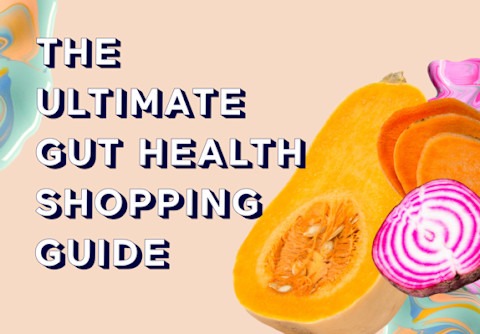Why People Who Eat These Healthy Foods May Feel More Bloated, According To An R.D.
Up to 30 percent of the population1 suffers from digestive complaints like gas and bloating. In my practice, I often see people turn to things like eliminating "unhealthy" foods to help their guts.
However, there are many healthy foods that are good for you but may not "agree with you," digestively speaking. The foods I'm talking about may not seem to have much in common, but they are all high FODMAP, which means that they are highly fermentable in your stomach—and this fermentation action often is the main culprit in chronic bloat.
FODMAP is an ugly acronym that stands for "fermentable oligosaccharides, disaccharides, monosaccharides, and polyols." These are all words you are probably not familiar with—but they are carbohydrates that are components of many common foods. While they are not necessarily "bad for you," they are a common cause of digestive complaints. This happens because some really healthy foods are tough for our intestines2 to break down. Bacteria that naturally live in our guts love to dine on these undigested foods, and the side effect of that is the production of excess gas, which leads to bloat.
These 10 healthy foods can be surprising causes of bloat for some people. Remember, everyone's body is different, so if you suspect one of these foods is causing your bloat, notice how it interacts with your body the next time you eat it, and think about eliminating it for a few weeks to see if you feel a difference.
1. Apples.
It turns out that an apple a day may not keep the doctor away. Although apples are full of fiber and antioxidants, they may also be responsible for causing an upset stomach. Apples are high in two different types of FODMAP carbohydrates (fructose and sorbitol) that can leave you feeling uncomfortable and distended. Next snack break, try an orange and handful of almonds instead.
2. Greek yogurt.
Greek yogurt is an inexpensive, quick, and easy way to get protein into your diet—but it may be making you bloated, as well. Lactose, which is found in many dairy products, especially yogurt, milk, and ice cream, may give you a bloated belly if you are lactose intolerant3. An enzyme called lactase, which many adults are lacking in, is needed to break down lactose into its digestible components. The good news is that you can try lactose-free yogurt as an alternative.
3. Mango.
The sugar that dominates in making mango delicious and sweet is the FODMAP fructose. It is common for fructose to be hard to absorb, giving you unwanted digestive side effects because it is easily fermented into gas. Swap out mango for pineapple, another tropical fruit that has less fructose.
4. Asparagus.
It’s green, it’s lean—it doesn’t even seem sweet. But asparagus is also high in the FODMAP fructose, making it a potential trigger for uncomfortable bloating. Swap out the asparagus for green beans if you suspect this is a problem food for you.
5. Chickpeas.
Beans, they are good for the heart, but they can be responsible for bloating as well. If chickpeas are a big part of your diet, you may find that buying canned chickpeas, eating small portions (less than ¼ cup), and rinsing them off will make them respond better in your system. The high-FODMAP component of chickpeas that makes them hard on your system (oligosaccharides) will largely be washed away when you rinse them.
6. Wheat.
It turns out that gluten is not the only ingredient in wheat that can cause digestive distress. While gluten is a protein, wheat also contains difficult-to-digest FODMAP carbohydrates. If you find that wheat is making you feel bloated, it may be the FODMAPs (not the gluten) disagreeing with you.
7. Pistachios.
In general, nuts are a great snack. They contain just the right amount of fat and protein to keep you feeling satisfied. While they're super healthy for some people, for others, pistachios may be one to skip. They can cause unwanted because they are high in oligosaccharides. If you find yourself bloated after you eat them, simply swap in another nut.
8. Garlic.
Garlic adds so much flavor and can even benefit your immune system—but it can also wreak havoc on your system. Garlic is a potent source of oligosaccharides, which sadly can be a recipe for bloating. From a FODMAP perspective, it doesn’t matter if they are cooked or raw (the oligos are still there), but many of my patients do report better tolerance to cooked garlic. If you do find cooked and raw garlic to be problematic, you can get all the flavors, sans bloat, by using garlic-infused oil.
9. Honey.
We think of honey as a better-for-you sugar, and it does have some health benefits and even antimicrobial properties. But when you look at what honey is made of at a molecular level, it has a lot of the FODMAP fructose (just like high-fructose corn syrup). Instead, try maple syrup, which has less bloat-inducing fructose.
10. Inulin.
When you see foods labeled as high-fiber, it looks like a healthier choice because most of us lack fiber in our diets. Many of these foods will contain the prebiotic fiber inulin—while this does increase the fiber content, it unfortunately also frequently turns up the dial on bloating. If this sounds familiar, look for nutrition bars without added inulin (or simply snack on whole foods).
Again, each of these healthy foods can be a great part of a nutritious diet. However, if you're noticing symptoms of bloat, consider swapping them out of your diet to see how you feel.

